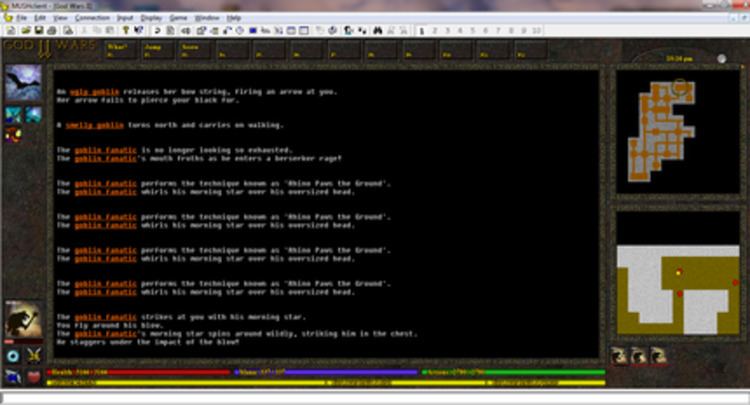 | ||
A MUD client is a computer application used to connect to a MUD, a type of multiplayer online game. Generally, a MUD client is a very basic telnet client that lacks VT100 terminal emulation and the capability to perform telnet negotiations. On the other hand, MUD clients are enhanced with various features designed to enhance the gameplay of MUDs.
Standard features seen in most MUD clients include ANSI color support, aliases, triggers and scripting. The client can often be extended almost indefinitely with its built-in scripting language. Most MUDs restrict the usage of scripts because they give an unfair advantage, as well as the fear that the game will end up being played by fully automated clients instead of human beings.
History
The first MUD client with a notable amount of features was Tinytalk by Anton Rang in January 1990, for Unix-like systems. In May 1990 TinyWar 1.1.4 was released by Leo Plotkin which was based on TinyTalk 1.0 and added support for event-driven programming. In September 1990 TinyFugue which was based on TinyWar 1.2.3 and TT 1.1 was released by Greg Hudson and featured more advanced trigger support. Development of TinyFugue was taken over by Ken Keys in 1991. TinyFugue has continued to evolve and remains a popular client today for Unix-like systems.
TinyFugue, or tf, was primarily written for Unix-like operating systems. It is one of the earliest MUD clients in existence. It is primarily geared toward TinyMUD variants. TinyFugue is extensible through its own macro language, which also ties to its extensive trigger system. The trigger system allows implementation of automatically run commands.
Another early client was TINTIN by Peter Unold in April 1992. In October 1992 Peter Unold made his final release, TINTIN III, which was a much more mature and feature rich program. Development of TINTIN was continued by Bill Reiss who announced the release of TinTin++ 1.0 in July 1993. The client gained popularity quickly because of its easy to use scripting language and the popularity of DikuMUD for which it was designed. Being open source with originally no license restrictions, many current clients like GGMud, MudMaster, and Pueblo are based on TinTin++.
Following on from TINTIN's success, Mike Potter was keen to produce a Windows port of the client resulting in the release of zMUD 1.0 in December 1995. zMUD was initially licensed as freeware, but Mike Potter realized that he could make a living from sales of the client and started selling zMUD 4.0 as shareware in September 1996.
